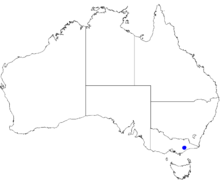Boronia galbraithiae
Boronia galbraithiae, commonly known as the aniseed boronia[2] or Galbraith's boronia,[3] is a plant in the citrus family Rutaceae and is endemic to a small area in Victoria. It is an erect, woody, fennel-scented, hairless shrub with pinnate leaves and white to deep pink, four-petalled flowers arranged in groups in the leaf axils.
| Aniseed boronia | |
|---|---|
| Scientific classification | |
| Kingdom: | Plantae |
| Clade: | Tracheophytes |
| Clade: | Angiosperms |
| Clade: | Eudicots |
| Clade: | Rosids |
| Order: | Sapindales |
| Family: | Rutaceae |
| Genus: | Boronia |
| Species: | B. galbraithiae |
| Binomial name | |
| Boronia galbraithiae | |
 | |
| Occurrence data from Australasian Virtual Herbarium | |
Description
Boronia galbraithiae is an erect, woody, fennel-scented shrub with glabrous, four-angled branches and that grows to a height of about 2 m (7 ft). It has pinnate leaves that are 12–30 mm (0.5–1 in) long and 5–14 mm (0.2–0.6 in) wide in outline on a petiole 4–9 mm (0.2–0.4 in) long with between seven and seventeen leaflets. The leaflets are lance-shaped to egg-shaped with the narrower end towards the base, mostly 2–9 mm (0.08–0.4 in) long and 1–3 mm (0.04–0.1 in) wide. The flowers are white to deep pink and are arranged in groups of mostly between three and five in leaf axils on a pedicel 3.5–22 mm (0.1–0.9 in) long. The four sepals are egg-shaped to triangular, 1–2 mm (0.04–0.08 in) long and 1–1.5 mm (0.04–0.06 in) wide and glabrous. The four petals are 4.5–8 mm (0.18–0.31 in) long, 2.5–3.5 mm (0.098–0.14 in) wide. The eight stamens are hairy and the style is about the same width as the stigma. Flowering occurs in spring and the fruit is a glabrous capsule about 4 mm (0.16 in) long.[3][4][5][6]
This boronia is similar to B. microphylla but differs in having glabrous branches.[5]
Taxonomy and naming
Boronia galbraithiae was first formally described in 1993 by David Edward Albrecht who published the description in the journal Muelleria.[7] The specific epithet (galbraithiae) honours Jean Galbraith who discovered the species.[4]
Distribution and habitat
Aniseed boronia grows in dry forest near Mount Difficult in East Gippsland.[3][5]
Conservation
Boronia galbraithiae is listed as "vulnerable" under the Australian Government Environment Protection and Biodiversity Conservation Act 1999 and the Victorian Government Flora and Fauna Guarantee Act 1988 and a recovery plan has been prepared. The main threats to the species include inappropriate fire regimes, roadworks and forestry operations.[2][6]
References
- "Boronia galbraithiae". Australian Plant Census. Retrieved 14 March 2019.
- Carter, Oberon. "National Recovery Plan for the Aniseed Boronia Boronia galbraithiae" (PDF). Australian Government Department of Sustainability and Environment. Retrieved 14 March 2019.
- Duretto, Marco F. (2003). "Notes of Boronia (Rutaceae) in eastern and northern Australia" (PDF). Muelleria. 17: 114–115. Retrieved 14 March 2019.
- Albrecht, David E.; Walsh, Neville G. (1993). "Two new species of Boronia (Rutaceae) endemic in Victoria" (PDF). Muelleria. 8 (1): 24–25. Retrieved 14 March 2019.
- Duretto, Marco F.; Wilson, Paul G.; Ladiges, Pauline Y. "Boronia galbraithiae". Australian Biological Resources Study, Department of the Environment and Energy, Canberra. Retrieved 14 March 2019.
- Walsh, Neville. "Boronia galbraithiae". Royal Botanic Gardens Victoria. Retrieved 14 March 2019.
- "Boronia galbraithiae". APNI. Retrieved 14 March 2019.
